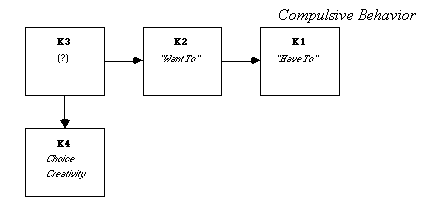The NLP Pattern of the Month:
Steps of the Pragmagraphic Swish Design Pattern
From Meta Position, physically lay out locations for (K1) "Have To," (K2) "Want To," (K3) "?," and (K4) "Creativity or Choice," as shown in the following diagram.

Layout for the Steps of the Pragmagraphic Swish Design Pattern
- Stand in the "Have To" location and identify a compulsive behavior and the specific feeling associated with doing it (K1) – i.e., what feeling do you experience when you "HAVE TO" do the compulsive behavior?
- Take a step backward to the "Want To" location and identify the response that comes just BEFORE K1 and the specific feeling (K2) associated with it – i.e., what response makes you "WANT TO" engage in the compulsive behavior?
- Take another step backward to the "?" location and identify the response that comes just BEFORE K2 and the specific feeling associated with it (K3) -– i.e., what response triggers the feeling of wanting to engage in the compulsive behavior? NOTE: This response will often be initially outside of the conscious awareness and may not ever have been consciously associated with the compulsive behavior before.
- Elicit the visual and auditory submodalities of K3 and determine which submodalities are critical in increasing the intensity of the feeling in such a way that it begins to lead you into "Wanting To" engage in the compulsive behavior (K2). Which submodalities decrease the "?" feeling of K3 so that you do not feel like you "Want to" do the compulsive behavior. Also determine which submodalities have no impact on the degree or quality of the K3 feeling.
- Step into the final location and identify a state of choice and creativity and the specific feelings (K4) that accompany choice and creativity.
- Elicit the visual and auditory submodalities that accompany K4 and determine which submodalities are critical in increasing/decreasing the intensity of K4. Also determine which submodalities have no impact on the degree or quality of the feeling.
- Find which critical submodality is SHARED by both K3 and K4. (eg. brightness)
- Step back into the "?" location. Start with the critical submodality for K3 in the most intensified state (eg. bright and close) and the critical submodality for K4 in the least intensified state (eg. dim and distant). Notice the degree to which you are "pulled" into the "Want to" location (K2). Slowly intensify the critical submodality for K4 as you simultaneously de-intensify the critical submodality for K3 (eg. have K4 get closer and brighter and K3 get dimmer and more distant) until their positions are completely switched. As you do this, slowly step from the "?" location into the location for choice and creativity (K4).
- Step away from the K4 location and repeat step 6 at least five times as fast as possible.
- Test by stepping back into the "?" location and noticing which direction you naturally feel like moving, toward K2 or K4? What happens when you try to go back to the compulsive feeling and behavior.
Also see the Article of the Month or the Archives if you are interested in checking out NLP in more depth.
For information on Robert Dilts’ products and services, please see Upcoming Seminars or Robert’s Product Page or return to Home Page.
If you have Suggestions or Comments concerning our WWW service, please send e-mail to the following address: michaelp@bowsprit.com.
This page, and all contents, are Copyright © 1998 by Robert Dilts., Santa Cruz, CA.

